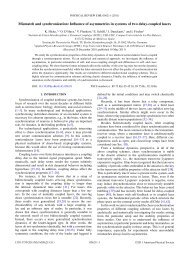DBI Analysis of Open String Bound States on Non-compact D-branes
DBI Analysis of Open String Bound States on Non-compact D-branes
DBI Analysis of Open String Bound States on Non-compact D-branes
You also want an ePaper? Increase the reach of your titles
YUMPU automatically turns print PDFs into web optimized ePapers that Google loves.
CHAPTER 6. SETTING 83through the induced metric, Kalb-Ram<strong>on</strong>d field and Maxwell field strength, these lasttwo <str<strong>on</strong>g>of</str<strong>on</strong>g> course <strong>on</strong>ly if present. Specifically, given the general pullback form,T αβ = ∂Xµ∂X α ∂X ν∂X β T µν, (6.13)with T µν some arbitrary tensor, partial derivatives <str<strong>on</strong>g>of</str<strong>on</strong>g> the perturbati<strong>on</strong>s will appear. Assuch, when <strong>on</strong>e computes the determinant <str<strong>on</strong>g>of</str<strong>on</strong>g> the resulting matrix (recall the general√−gαβ + B αβ + 2πα ′ F αβ term in the <str<strong>on</strong>g>DBI</str<strong>on</strong>g> acti<strong>on</strong>), and expands the square root, <strong>on</strong>eis typically left with a number <str<strong>on</strong>g>of</str<strong>on</strong>g> zero, first and sec<strong>on</strong>d order partial derivatives <str<strong>on</strong>g>of</str<strong>on</strong>g> theexpansi<strong>on</strong>s. By computing the equati<strong>on</strong>s <str<strong>on</strong>g>of</str<strong>on</strong>g> moti<strong>on</strong> <str<strong>on</strong>g>of</str<strong>on</strong>g> this Lagrangian density, <strong>on</strong>eobtains a differential equati<strong>on</strong> for the perturbati<strong>on</strong>s. By solving this equati<strong>on</strong>, <strong>on</strong>e cananalyse the spectrum <str<strong>on</strong>g>of</str<strong>on</strong>g> the perturbati<strong>on</strong>s.Summarized in short, to obtain the spectrum <str<strong>on</strong>g>of</str<strong>on</strong>g> the perturbati<strong>on</strong>s <str<strong>on</strong>g>of</str<strong>on</strong>g> a D-brane usingthe <str<strong>on</strong>g>DBI</str<strong>on</strong>g> acti<strong>on</strong>, and hence <str<strong>on</strong>g>of</str<strong>on</strong>g> the low-energy excitati<strong>on</strong>s <str<strong>on</strong>g>of</str<strong>on</strong>g> the D-brane, <strong>on</strong>e shouldfirst write down the <str<strong>on</strong>g>DBI</str<strong>on</strong>g> acti<strong>on</strong> for the D-brane in the geometry under c<strong>on</strong>siderati<strong>on</strong>,compute the classical soluti<strong>on</strong>, introduce perturbati<strong>on</strong>s, compute the equati<strong>on</strong>s <str<strong>on</strong>g>of</str<strong>on</strong>g> moti<strong>on</strong><str<strong>on</strong>g>of</str<strong>on</strong>g> these perturbati<strong>on</strong>s, and combine them into a differential equati<strong>on</strong>. The soluti<strong>on</strong>s <str<strong>on</strong>g>of</str<strong>on</strong>g>this differential equati<strong>on</strong> tells you the spectrum <str<strong>on</strong>g>of</str<strong>on</strong>g> the perturbati<strong>on</strong>s.6.5 How to recognize bound statesThe last questi<strong>on</strong> left to answer is how to known whether or not the spectrum c<strong>on</strong>tainsbound states.The crucial point is that in order to solve the equati<strong>on</strong>s <str<strong>on</strong>g>of</str<strong>on</strong>g> moti<strong>on</strong> for the perturbati<strong>on</strong>s,<strong>on</strong>e always proposes a factorized soluti<strong>on</strong> c<strong>on</strong>taining a quantum mechanical e iEtterm to remove the always present ∂ 2 t term. This term is always present, because theperturbati<strong>on</strong>s are always c<strong>on</strong>sidered to be time dependent, which by virtue <str<strong>on</strong>g>of</str<strong>on</strong>g> the pullbackmechanism amounts to such a sec<strong>on</strong>d time derivative. This introduces the energy<str<strong>on</strong>g>of</str<strong>on</strong>g> the fluctuati<strong>on</strong>s in the differential equati<strong>on</strong>.Using E 2 = m 2 + p 2 , we can relate this energy to the mass <str<strong>on</strong>g>of</str<strong>on</strong>g> the particles. If <strong>on</strong>emanages to solve the differential equati<strong>on</strong>s resulting from the equati<strong>on</strong>s <str<strong>on</strong>g>of</str<strong>on</strong>g> moti<strong>on</strong>, <strong>on</strong>ecan also derive which values <str<strong>on</strong>g>of</str<strong>on</strong>g> E 2 are allowed by the soluti<strong>on</strong>. A priori, if nothingbounds the particles, this energy is arbitrary since nothing bounds their impulse, i.e.p ∈ [0, +∞[, resulting in a c<strong>on</strong>tinuous spectrum. However, for a bound state p = 0, andso the small mass (E 2 = m 2 ) <str<strong>on</strong>g>of</str<strong>on</strong>g> the particle will reveal itself through a discrete value <str<strong>on</strong>g>of</str<strong>on</strong>g>the energy laying below the c<strong>on</strong>tinuum spectrum.
















